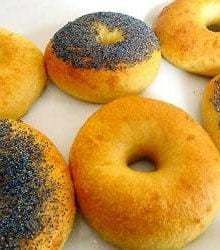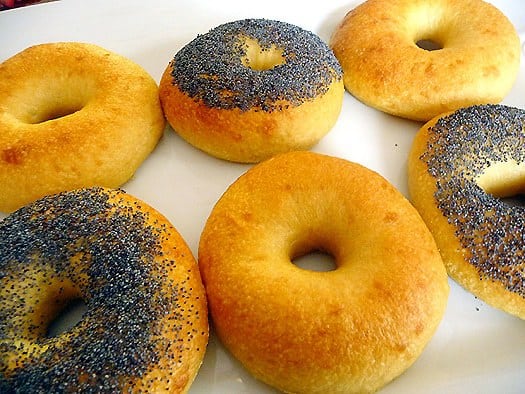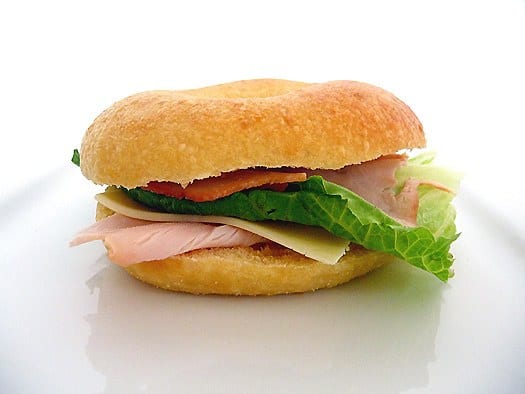Egg Bagels
A few weeks ago I realized that I hadn’t made bagels in a few months and that I was long overdue for whipping up a batch. I asked my Chief Culinary Consultant if he wanted Cinnamon Raisin Bagels (his favorite), plain bagels or something different. He mentioned that he’s always been a fan of egg bagels and wouldn’t mind if I were to tackle a batch of those. I love getting ideas for new things, and jumped at the chance to make them. I ran into a problem, however, after poring over every cookbook I own and realizing that none of them had a recipe for egg bagels. I turned to the web and found multiple recipes that were all very, very similar, so I gave it a shot and they were okay, but certainly didn’t live up to the standard I was used to, which were all variations on Peter Reinhart‘s basic bagel recipe. A light bulb finally went off and I emailed Peter to see if he had a recipe for egg bagels that perhaps hadn’t been published, and he was wonderfully generous with his time and explained to me how I could adapt his basic recipe for bagels to make egg bagels.
To sum things up, Peter basically stated that I should add 1 egg (or just 1 yolk for a richer egg bagel, which is what I chose to do) per 1 cup of flour. Since eggs have water content, there needs to be an adjustment of the water that goes into the recipe. As a general rule of thumb, each whole egg contains 1.5 ounces of water, while yolks contain about 0.5 ounce of water. Given those guidelines, I made the adaptation to his original recipe and have shared it below.
Save This Recipe
The bagels turned out absolutely fabulous! My Chief Culinary Consultant said that while the cinnamon raisin bagels are still his favorite because he loves the flavor, that these egg bagels were, without question, the best bagels I have ever made in terms of texture and traditional bagel flavor. High praise, indeed! A great big thank you to Peter for taking the time to help me create this recipe!!
While I was looking around the cyber world for egg bagel recipes, I read that egg bagels topped with poppy seeds are traditional Jewish fare, which is something I didn’t know. In an attempt to be authentic, I made half of the bagels “regular” plain egg bagels and topped the other half with popppy seeds. Both were phenomenal – the poppy seed egg bagels were great with cream cheese, and the egg bagels were fantastic as typical bagels and also made awesome sandwiches!
1 year ago: Apple Hand Pies
2 years ago: Brown Sugar Raisin Bread

Egg Bagels
Ingredients
Sponge:
- 1 teaspoon instant yeast, (.11 ounce )
- 4 cups (500 g) unbleached high-gluten flour or bread flour, (18 ounces )
- 2 cups (500 ml) water, at room temperature, (16 ounces )
Dough:
- ½ teaspoon (0.5 teaspoon) instant yeast, (.055 ounce)
- 3¾ cups (468.75 g) unbleached high-gluten or bread flour, (17 ounces )
- 8 egg yolks
- 2¾ teaspoons (2.75 teaspoons) salt, (.7 ounce )
- 2 teaspoons malt powder OR 1 Tablespoon dark or light malt syrup, honey or brown sugar, (.33 ounce )
To Finish:
- 1 Tablespoon baking soda
- Cornmeal or semolina flour for dusting
- Poppy seeds, optional
Instructions
- 1. To make the sponge, stir the yeast into the flour in a 4-quart mixing bowl. Add the water, whisking or stirring only until all of the flour is hydrated. Cover the bowl with plastic wrap and leave at room temperature for approximately 2 hours, or until the mixture becomes very foamy and bubby. It should swell to nearly double in size and collapse when the bowl is tapped on the countertop.
- 2. To make the dough, in the same mixing bowl (or in the bowl of an electric mixer), add the additional yeast to the sponge and stir. Then add 3 cups of the flour, the egg yolks and all of the salt and malt. Stir (or mix on low speed with the dough hook) until the ingredients form a ball, slowly working in the remaining ¾ cup flour to stiffen the dough.
- 3. Transfer the dough to the counter and knead for at least 10 minutes (or for 6 minutes by machine). The dough should be firm, stiffer than French bread dough, but still pliable and smooth. There should be no raw flour - all the ingredients should be hydrated. The dough should pass the windowpane test and register 77° to 81°F. If the dough seems too dry and rips, add a few drops of water and continue kneading. If the dough seems tacky or sticky, add more flour to achieve the stiffness required. The kneaded dough should feel satiny and pliable but not be tacky.
- 4. Immediately divide the dough into 4½-ounce pieces for standard bagels, or smaller if desired. Form the pieces into rolls.
- 5. Cover the rolls with a damp towel and allow them to rest for approximately 20 minutes.
- 6. Line 2 sheet pans with baking parchment and mist lightly with spray oil. Proceed with one of the following shaping methods:
- 6a. Poke a hole in a ball of bagel dough and gently rotate your thumb around the inside of the hole to widen it to approximately 2½ inches in diameter. The dough should be as evenly stretched as possible (try to avoid thick and thin spots).
- 6b. Roll out the dough into an 8-inch-long rope. Wrap the dough around the palm and back of your hand, between the thumb and forefinger, overlapping the ends by several inches. Press the overlapping ends on the counter with the palm of your hand, rocking back and forth to seal.
- 7. Place each of the shaped pieces 2 inches apart on the pans. Mist the bagels very lightly with the spray oil and slip each pan into a food-grade plastic bag, or cover loosely with plastic wrap. Let the pans sit at room temperature for about 20 minutes.
- 8. Check to see if the bagels are ready to be retarded in the refrigerator by using the "float test". Fill a small bowl with cool or room-temperature water. The bagels are ready to be retarded when they float within 10 seconds of being dropped into the water. Take one bagel and test it. If it floats, immediately return the tester bagel to the pan, pat it dry, cover the pan, and place it in the refrigerator overnight (it can stay in the refrigerator for up to 2 days). If the bagel does not float, return it to the pan and continue to proof the dough at room temperature, checking back every 10 to 20 minutes or so until a tester floats. The time needed to accomplish the float will vary, depending on the ambient temperature and the stiffness of the dough.
- 9. The following day (or when you are ready to bake the bagels), preheat the oven to 500°F with the two racks set in the middle of the oven. Bring a large pot of water to a boil (the wider the pot the better), and add the baking soda. Have a slotted spoon or skimmer nearby.
- 10. Remove the bagels from the refrigerator and gently drop them into the water, boiling only as many as comfortably fit (they should float within 10 seconds). After 1 minute flip them over and boil for another minute. If you like very chewy bagels, you can extend the boiling to 2 minutes per side. While the bagels are boiling, sprinkle the same parchment-lined sheet pans with cornmeal or semolina flour. (If you decide to replace the paper, be sure to spray the new paper lightly with spray oil to prevent the bagels from sticking to the surface.) If you want to top the bagels, do so as soon as the come out of the water.
- 11. When all the bagels have been boiled, place the pans on the 2 middle shelves in the oven. Bake for approximately 5 minutes, then rotate the pans, switching shelves and giving the pans a 180-degree rotation. (If you are only baking 1 pan, keep it on the center shelf but still rotate 180 degrees.) After the rotation, lower the oven setting to 450°F and continue baking for about 5 minutes, or until the bagels turn light golden brown. You may bake them darker if you prefer.
- 12. Remove the pans from the oven and let the bagels cool on a rack for 15 minutes or longer before serving.
Did you make this recipe?
Leave a review below, then snap a picture and tag @thebrowneyedbaker on Instagram so I can see it!








I am so thrilled that you posted this recipe, I have been making it for the past year to perfection every time. THANK YOU!
It became so difficult to get egg bagels in Boston after the lock down had been lifted, then it became a memory after the second lock down, holding out for our next trip into NYC was, aggravating as we only went into The City, twice a year and not likely for superior bagels. I know the bird flu situation played it’s part, but we (my husband and our 3 youngest children), transferred from Massachusetts to Iowa where none are even offered. You have made my weekend mornings a joy again, thank you Michelle.
A pint is a pound the world around. It’s not exact when measuring wet and dry, but it is close.
Perhaps halve the flour. I will experiment. I have Peter’s book, so I will look in there too.
NEW to this recipe so I have questions.
When does the sponge get mixed in or used? Is there a recommended thermometer?
I made these for the first time. The sponge did take three hours to bubble, but the dough was beautifully smooth. I fermented the 12 shaped bagels for 36 hours before poaching. I added barley malt syrup to the poaching water. The result was a big, puffed, chewy egg bagel with a nice crust. Thank you.
add more egg yolks is a must. otherwise they taste and look like regular old bagels.
also, room temp water for instant yeast? dont recipe liquids need to be around 110 or so (dep on the brand used), even if it doesnt need to be activated?
ex: some yeast requires activation in warm water. others dont require it but let you add to flour and follow recipe as needed, but it also says to make sure liquids used in the recipe like water are that warm to keep the yeast alive.
my dough didnt rise a ton and it def didnt foam or froth up and flatten with a tap. i still went through the whole thing and while the bagels were kinda crusty, they were still good and not hard, dough was just way too dry with the called for quantities (is why im adding more yolks this time).
but i still cant figure the yeast thing out
You probably added too much flour. The humidity where you lives affects the humidity of the flour that you use.
Room temperature is pretty well standard when you are making a sponge, biga, poolish, or preferment ahead of making the main dough.
I made these but I used twice the amount of eggs and half the flour. HIGHLY RECOMMENDED!!! :)
I’m going to make these with a little variation. I’m going to add bacon bits to the batter and sprinkle with shredded sharp cheddar cheese before baking.
Very fun recipe for egg bagels.
I like making these with farm fresh eggs. Delicious! I make a half a recipe; 6 bagels.
Ok, I’ve been on a DIY-home-bagel-baking mission for almost a year. This egg bagel recipe totally nails it. Clear, concise instructions yielding perfect results. Thank you BEB.
Hello, looks amazing. Will try this weekend. Question:
I have a proof setting on my oven. Would it be bad to let the sponge proof at 90F ?
Hi Jason, I would not recommend the proof setting, as that is much warmer than the room temperature it should be resting at. Enjoy the bagels!
These bagels look amazing and taste ok, not chewy. I’m confused? How does essentially 8-cups of flower (4-cups for sponge and 3 3/4 cup of flour for the dough), only make 12- bagels? I made 16 and they are a perfect size, a little on the big side…
Other people’s comments re the amount of flower are what seem to be the problem… My bagels from beginning to end came out of each stage were really good, although the sponge seemed way too dry (4-cups of flour? Seems like someone should look at and adjust the most 8-cups of flower for 12-bagels? Seems like those that used 18-ounces of flour versus the 4-cups measurement have different results?
I’ve been making regular bagels for a while and they’ve been turning out quite well. I tried this egg bagel recipe and something went terribly awry. The bagels completely deflated when in the fridge. They were like balloons. I tried reshaping some of them and those puffed up like dinner rolls. I think I’ll stick with my old recipe.
I’m confused by the sponge measurements. The recipe calls for 4 cups of flour (18 ounces). But 4 cups = 32 ounces. Which is it?
Hi Molly, 8 ounces = 1 cup is a standard liquid measurement. Solids have vastly different weights per volume. For example, 1 cup of all-purpose flour can weight 4 to 5 ounces, while 1 cup of granulated sugar is usually around 7 ounces. I hope this clears up any confusion!
Hi, I’m planning on making these tomorrow,my 6 and 4 year old are obsessed with egg bagels. I’m just confused about the sponge. Do I make the sponge let it sit for two hours and then combine it with the dough process? So after the 2 hour wait time for the sponge I mix the sponge in with step 2 (making the dough) sorry i’m new to this and never heard of the “Sponge”.
Thanks!
Hi Karen, Yes you are correct – make the sponge, let it sit for 2 hours, then proceed with the remaining recipe. Enjoy!
Was just scratching my head trying to guess at how to adapt the Reinhart recipe, so thank you for this! Excited to get cracking!
Flavor is spot on. Mine were a little fluffier than I would have liked and didn’t have quite as crisp a crust as bagel shop bagels, but that was definitely my fault. I didn’t have bread flour, so I used all purpose and I suspect I should have boiled them a bit longer. I’m sure with bread flour and a little longer boiling time the minor issues I had would have gone away. Great recipe, I will definitely use it again! They didn’t come out as yellow as the egg bagels I’m used to, but I imagine the color is probably achieved with the help of some food coloring
I grew up only eating egg bagels in Trenton NJ and learned to love them. I found your recipe after some searching. I decided to give it a try but eggs are at a premium during this shutdown of sorts. I cut the recipe by 75% so I only needed two egg yolks. The recipe yielded three bagels. I am new to baking, about six months now. Everything went just as you described in the recipe. I am now the envy of my family and friends even though my wife and I ate them. Pictures to everyone I know though. I’m goin to make a full batch today, tomorrow! I have some kippered salmon just itching to be put on top with cream cheese and onion and tomato! I can’t say thank you enough for this incredible recipe! One last note, I don’t know the experience level of all the other bakers who have mad comments but I’m sure I have less experience in baking and it was super easy and fun! So if someone had a problem with the outcome try again and follow the directions to the T and you will get the perfect bagel! Thanks again!!
These were just what I was looking for. I recognized the recipe from Peter Reinhart before i read the intro, so I knew they would be good.
I tried to email him and found out the breadfrontier address is no longer valid…I envy your access to him!
The last I connected with him was many, many years ago, but he was always incredibly gracious with his time when I was trying to adapt one of his recipes.
Helol! I am in the process of trying your recipe and am a little confused on the sponge. I am using bread flour and brand new dry active yeast. I weighed out the flour (18 ounces) and used 16 ounces of water. The combination made for a shaggy dough instead of a wet thick batter (which is common with sponge). Should there be more water for the sponge than 16 ounces?
Thank you!
Hi Erika, That is the correct measurement.
I had the same question Erica. I was worried I put a cup too much flour on accident somehow. The sponge was much more thick or bread like than I had anticipated . I
I use the standard parchment paper available in most stores, but the instructions on the box actually say not to use above 420F. And Silpats aren’t food safe above 480F. Thoughts? I think next time I’ll go with cornmeal and a baking stones instead.
My bagels tasted great…but like great bread, not great bagels. I kneaded like a boss (I make bread routinely). my dough seemed perhaps a little tacky, but didn’t create quite the window pane before it tore. By your descriptions in #3, my dough was too wet and too dry. Should I have kneaded longer? Also, I boiled for precisely one minute each side, but the chew just wasn’t there…at all. I actually don’t love chewy bagels, but my husband even said they just seemed like good bread.
I had a few questions while making this recipe, but after everything was said and done they turned out really well. I did boil them longer than stated, 3 minutes per side, because I read a different recipe that said the bagels would have a bit more chewiness to them.
When I make them again I will add a bit more water to the sponge portion, as I had dry flour in my bowl. Also it took putting the sponge in the warm oven to get it to rise.
Next time I will warn my metal mixer bowl before starting the recipe process.
Another question, when making the sponge. there were still some dry flour spots that didn’t get wet when using only the 2 cups of water! Should I have added additional water to it until it was fully moistened??
Using 18oz flour and 16oz water should make a pretty darn wet sponge. It may take longer to get the bubbly appearance of the sponge if your house is cool or if you used active dry yeast instead of instant, or if your dough is too dry.
I’m making the egg bagels, and am in the “sponge process”. It has been resting for 2 hours now, but it hasn’t risen as much as you stated it should, nor is it foamy and bubbly!!
What should I do?? HELP!!
I made these and I love them! I needed to add water as my dough could not come together without it. They are a great (large) size and have a nice medium texture. It was a large recipe and my Kitchenaid was mad at me. I also brushed my bagels with an egg white/water mix to make them shiny! I took a pic of my batch and put it on my FB bread baking group page and gave this recipe link!
Peter basically stated that I should add 1 egg (or just 1 yolk for a richer egg bagel, which is what I chose to do) per 1 cup of flour.” I, too, plan to use only the yolk. However, the completed recipe calls for 8 yolks for 4 cups of flour. Did you decide to double the recommendation? If so, can you tell about why you decided to do that? I’m asking because I love cooking, but my husband is not a foodie, so I go to great lengths to try to make something he will sit up and take notice of. I’ve been timid about bagels because I am from AL and he is from NYC. He is a bagel fanatic. Well, bagels, pizza, and Sabrett hot dogs. Now that we are retired and living in Italy I’ve pretty much got the pizza thing down. I found a NYT recipe for basic bagels and, after tracking down diastatic malt syrup, secretly (We have two refrigerators for the overnight rise) tried it. They were an amazing success and deemed, “Perfect!”. However, I knew egg bagels were his ultimate dream so I came your site. Now, my feet are to the fire to come up with the perfect egg bagel. So, can you give me an edge by giving up the info on the yolks? Many thanks!
Best guess: the recipe accounts for the flour in the dough AND in the sponge.